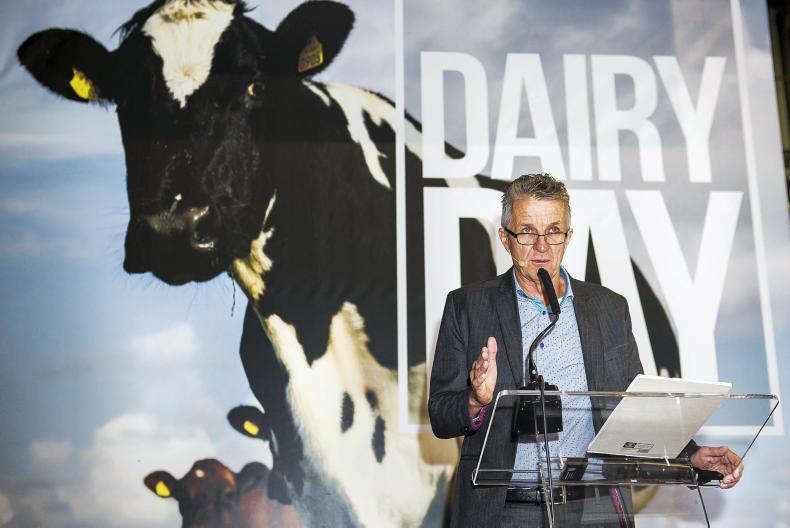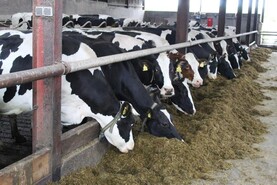The long-term outlook for the dairy industry appears positive, but it must undergo significant change in order to survive the cyclical nature of price volatility.
This was a common viewpoint expressed by speakers at last week’s dairy day in Punchestown organised by the Irish Farmer Journal.
Among them was New Zealand dairy farmer and former Fonterra board member Greg Gent who outlined how growing demand for protein within Asian markets offers huge opportunities for New Zealand’s dairy sector. However, the challenge will be to spread the risks associated from an over-reliance on one market for exports.
New Zealand exports 95% of milk produced, with 40% sold into Chinese markets. The strength of farmgate prices in New Zealand is therefore directly influenced by the strength of the Chinese economy.
Gent said milk production in New Zealand has more or less peaked, with fewer farms converting to dairying this year. Environmental legislation, and the requirement for government permits to convert farmland to dairying, has partially halted dairy expansion. A lack of farm finance is another barrier, as banks are more risk averse after dairy markets collapsed in 2015.
The outlook for milk price in New Zealand next year is estimated at $6.20/kg milk solids (MS), down from $6.52kg/MS this year.
Gent also came with a warning to Irish farmers considering expansion on the back of improved prices this year. New Zealand farmers who expanded from an inefficient base in 2014 when milk price was $8.50/kg MS, have since exited the sector, as they could not operate when prices collapsed to $4.30/kg in 2015.
Competitiveness
Also speaking was Irish dairy consultant Joe Gill, who said Irish processors need to rationalise either through amalgamating processing sites or combining milk pools to improve their competitiveness in global markets.
Irish milk production is set to grow to 10bn litres by 2030, which would see the national herd increase from 1.4m to 2m cows.
Gill said processing facilities across Ireland are too fragmented and too small to handle this increased volume efficiently, and still pay a competitive milk price to farmers. Therefore, rationalisation is the next logical step for the industry.
Northern co-ops predicting growth
While growth in the volume of milk being produced in NI has generally slowed in recent years, expansion looks set to continue across the Irish border.
Speaking at the Irish Farmers Journal Dairy Day held last week, chairs from a number of Irish co-ops were predicting 5% to 8% annual growth in volumes over the next few years.
That included significant buyers of milk in NI, such as Lakeland, Glanbia and Aurivo, with Lakeland chair Alo Duffy estimating that its volumes will rise from 1.2bn litres at present, to 1.5bn litres by 2020.
However, with a €40m investment in a new milk powder plant at Ballieboro opened earlier this year, the Lakeland chair suggested that future investment in the business will not be on stainless steel, but on driving efficiency and taking out costs.
His counterpart in Aurivo, Pat Duffy, is also expecting growth to continue, predicting that the co-op will move from being a 350m litre, to a 500m litre business by 2022.
“We are investing in our farms. We are investing in our sites. Every litre has found new homes and new markets. Customers are looking for milk, and we are able to supply it,” he said.
Meanwhile, Henry Corbally, the chair of Ireland’s largest co-op, Glanbia, expects 30% growth in volumes to 2020.
“That’s what our farmers’ survey has told us. Our aim is to get as far up the value chain as we can,” he said.
Margin
However, for co-ops mainly reliant on NI milk, much of the growth has happened in the last 10 years. “We are still experiencing growth, but it isn’t rapid growth. Growth in NI happens where there is a margin. It’s all about milk price, milk price, milk price – without farmers we don’t have an industry,” said Dale Farm chair John Dunlop.
He emphasised that the Dale Farm strategy is now on building relationships and partnerships with British retailers, and mainly selling them cheese and whey products. “We made the decision a few years ago that powder was not the future for us” he said.
He also highlighted that volatility in milk markets is here to stay, and that it was up to co-ops to have the right tools (such as fixed milk price schemes) to help manage the situation.
Value
Also sharing the stage was the new LacPatrick chair, Andrew McConkey, who referred to the major new £30m investment in a powder plant now up and running at Artigarvan in Co Tyrone.
He maintained that rather than investing more money in the business, the next few years would be about extracting the value of that investment for the benefit of LacPatrick suppliers.






 This is a subscriber-only article
This is a subscriber-only article










SHARING OPTIONS: